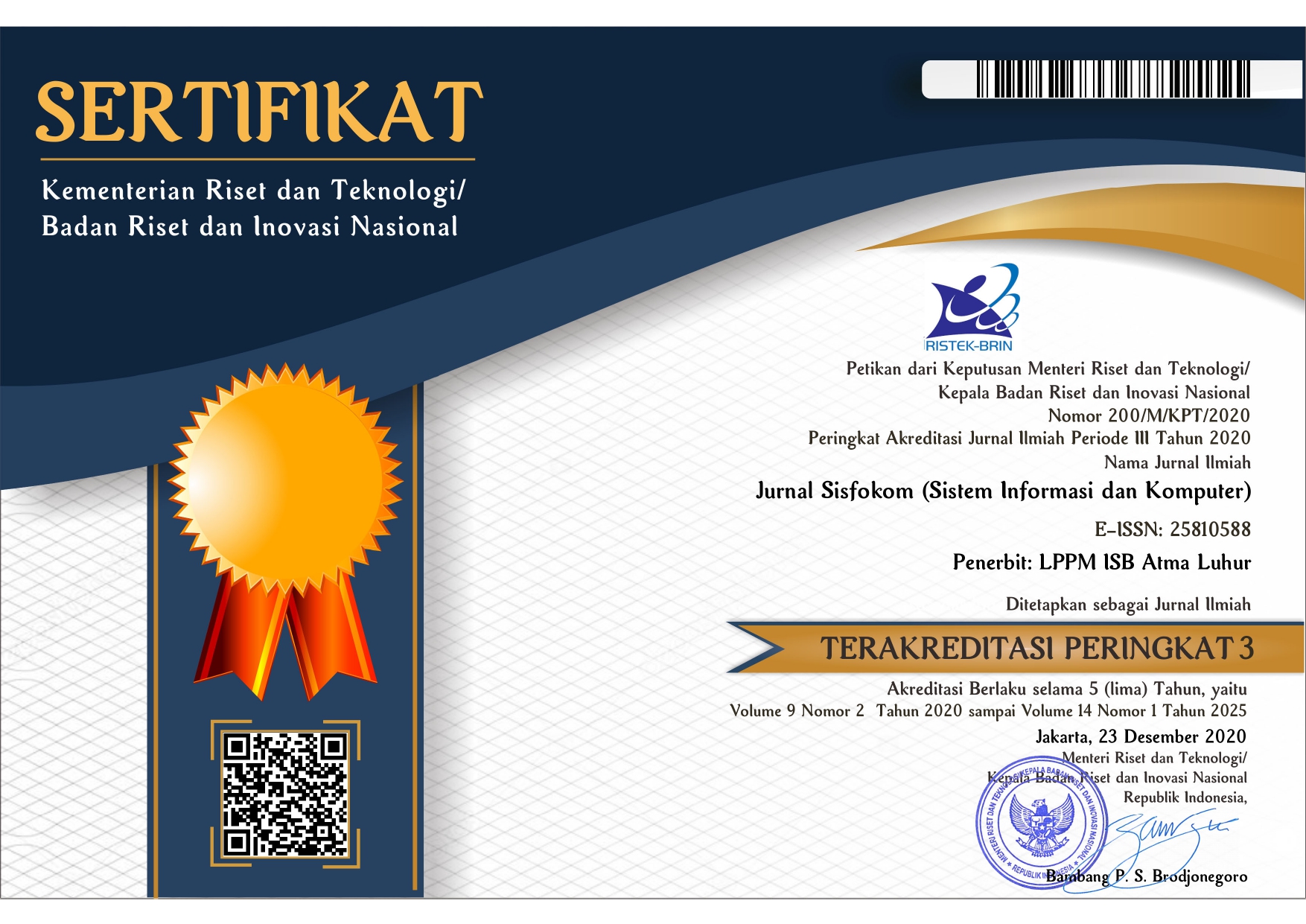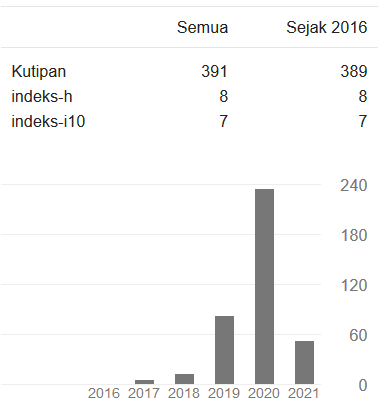Decision Support System for Selection of Pesticides in Chili Plants Using the MAUT Method
DOI:
https://doi.org/10.32736/sisfokom.v12i2.1669Keywords:
Chili Plant, MAUT Method, PesticidesAbstract
Diseases in chili plants often cause farmers to experience crop failure. Diseases that are often encountered are leaf spot disease, wilt disease, and anthracnose disease caused by fungi. Therefore, farmers are trying to prevent and reduce the disease by using pesticides. The use of pesticides in agriculture plays a role in preventing and reducing diseases in chili plants. Pesticides for chili plants are quite widely spread on the market and have the advantages of each product offered to farmers, so farmers must be more careful and understanding in choosing pesticides to be used in preventing chili plant diseases. For that we need a decision support system (SPK). The purpose of this research is to apply the MAUT method in SPK which can help chili farmers in selecting pesticides. The data used in this study are 10 types of pesticides as an alternative. While the criteria consist of price, classification, number of diseases eradicated, method of action, shelf life, and formulation concentration. Data analysis uses the MAUT method with the steps of forming a decision matrix, normalizing the decision matrix, determining the utility matrix, calculating the final utility, and ranking. The research results obtained for the three best pesticides are Tridex 80 WP, Ziflo 76 WG, and Cabriotop 60 WG.References
N. Hadinata, “Implementasi Metode Multi Attribute Theory(MAUT) pada Sistem Pendukung Keputusan dalam Menentukan Penerima Kredit,” SISFOKOM (Sistem Inf. dan Komputer), vol. 7, no. 2, pp. 87–92, 2018.
R. Kariman, H. Priyanto, and H. Sastypratiwi, “Implementasi Metode Multi Attribute Utility Theory (MAUT) pada Aplikasi Pemilihan Staf Berprestasi Dinas Pangan Pertanian dan Perikanan Kota Pontianak,” JUSTIN (Jurnal Sist. dan Teknol. Inf. ), vol. 8, no. 2, pp. 212–217, 2020, doi: 10.26418/justin.v8i2.38234.
M. I. Nasution, A. Fadlil, and Sunardi, “Perbandingan Metode SMART dan MAUT untuk Pemilihan Karyawan pada Merapi Online Corporation,” JTIIK (Jurnal Teknol. Inf. dan Ilmu Komputer), vol. 8, no. 6, pp. 1205–1214, 2021, doi: 10.25126/jtiik.2021863583.
F. El Khair, S. Defit, and Y. Yuhandri, “Sistem Keputusan dengan Metode Multi Attribute Utility Theory dalam Penilaian Kinerja Pegawai,” J. Inf. dan Teknol., vol. 3, no. 4, pp. 215–220, 2021, doi: 10.37034/jidt.v3i4.155.
E. Satria, N. Atina, M. E. Simbolon, and A. P. Windarto, “SPK: Algoritma Multi-Attribute Utility Theory (MAUT) pada Destinasi Tujuan Wisata Lokal di Kota Sidamanik,” CESS (Computer Eng. Syst. Sci., vol. 3, no. 2, pp. 168–172, 2018, doi: 10.24114/cess.v3i2.9954.
Ramadiani, H. R. Hatta, N. Novita, and Azainil, “Comparison of Two methods Between TOPSIS and MAUT in Determining BIDIKMISI Scholarship,” ICIC (International Conf. Informatics Comput., vol., no., p., 2018, doi: 10.1109/IAC.2018.8780455.
W. Apriani, “Sistem Pendukung Keputusan Pemilihan Pimpinan dengan MetodeMulti Attribute Utility Theory(MAUT) di PT.Sagami Indonesia,” J. Mantik, vol. 3, no. 2, pp. 10–19, 2019, [Online]. Available: https://iocscience.org/ejournal/index.php/mantik/index
T. Imandasari, A. P. Windarto, and D. Hartama, “Analisis Metode MAUT pada Pemilihan Deodorant,” SAINTEKS (Seminar Nas. Teknol. Komput. Sains), vol., no., pp. 736–739, 2019, [Online]. Available: https://seminar-id.com/semnas-sainteks2019.html
T. Limbong and J. Simarmata, “Menentukan Matakuliah yang Efektif Belajar Daring (Belajar dan Ujian) dengan Metode Multi-Attribute Utility Theory (MAUT),” J. RESTI (Rekayasa Sist. dan Teknol. Informasi), vol. 4, no. 2, pp. 370–376, 2020, doi: 10.29207/resti.v4i2.1851.
A. Adam, A. Fuad, H. Kurniadi Siradjuddin, and S. N Kapita, “Sistem Pendukung Keputusan Pemilihan Dosen Berprestasi Di Universitas Khairun Ternate Menggunakan Metode Multi- Attribute Utility Theory,” JIKO (Jurnal Inform. dan Komputer), vol. 3, no. 3, pp. 166–172, 2020, doi: 10.33387/jiko.v3i3.2246.
A. A. Kusuma, Z. M. Arini, U. Hasanah, and Mesran, “Analisa Penerapan Metode Multi Attribute Utility Theory (MAUT) dengan Pembobotan Rank Order Centroid (ROC) Dalam Pemilihan Lokasi Strategis Coffeshop Milenial di Era New Normal,” J. Sist. Komput. dan Inform., vol. 3, no. 2, pp. 51–59, 2021, doi: 10.30865/json.v3i2.3575.
Sukamto, Y. Andriyani, and I. D. Id, “Aplikasi Metode VIKOR untuk Menentukan Penerimaan Proposal Kegiatan Desa,” Komput. Terap., vol. 8, no. 2, pp. 336–345, 2022.
Sukamto, I. D. Id, and A. D. Jukris, “Penerapan Metode TOPSIS untuk Menentukan Kelayakan Perpustakaan Sekolah Diakreditasi,” SISFOKOM (Sistem Inf. dan Komputer), vol. 12, no. 1, pp. 24–29, 2023.
Y. Setiawan and S. Budilaksono, “Sistem Pendukung Keputusan Pemilihan Mahasiswa Lulusan Terbaik dengan Menggunakan Metode Multi Attribute Utility Theory (MAUT) di STMIK Antar Bangsa,” Ikraith-Informatika, vol. 6, no. 2, pp. 12–20, 2022, doi: 10.37817/ikraith-informatika.v6i2.1566.
D. H. Ramadan, M. R. Siregar, and S. Ramadan, “Penerapan Metode MAUT dalam Penentuan Kelayakan TKI dengan Pembobotan ROC,” J. Media Inform. Budidarma, vol. 6, no. 3, pp. 1789–1795, 2022, doi: 10.30865/mib.v6i3.4441.
Y. A. Situmorang, N. Dalimunthe, I. Parlina, and M. R. Lubis, “Penerapan Metode MAUT pada Pemilihan Bimbingan Intensif Terbaik di Pematangsiantar,” KOMIK (Konferensi Nas. Teknol. Inf. dan Komputer), vol. 2, no. 1, pp. 249–255, 2018, doi: 10.30865/komik.v2i1.934.
Elviani, E. Haerani, E. P. Cynthia, F. Kurnia, and F. Syafira, “Sistem Pendukung Keputusan Penilaian Kinerja Guru Menggunakan Metode Multi Attribute Utility Theory (MAUT),” JIPI (Jurnal Ilm. Penelit. dan Pembelajaran Inform., vol. 7, no. 3, pp. 993–1004, 2022, doi: 10.55606/jitek.v2i3.545.
J. H. Lubis, S. Esabella, M. Mesran, D. Desyanti, and D. M. Simanjuntak, “Penerapan Metode Multi Attribute Utility Theory (MAUT) dalam Pemilihan Karyawan yang di Non-Aktifkan di Masa Pandemi,” J. Media Inform. Budidarma, vol. 6, no. 2, pp. 969–978, 2022, doi: 10.30865/mib.v6i2.3909.
Sunardi, R. Umar, and D. Sahara, “Best Employee Decision Using Multi Attribute Utility Theory Method,” J. RESTI (Rekayasa Sist. dan Teknol. Informasi), vol. 6, no. 6, pp. 945–951, 2022, doi: 10.29207/resti.v6i6.4318.
M. M. Boangmanalu, Mesran, and B. Purba, “Implementasi Metode MAUT dalam Seleksi Calon Marketing Retail dengan menerapkan pembobotan ROC,” J. Ilm. Media SISFO, vol. 16, no. 2, pp. 81–91, 2022, doi: 10.33998/mediasisfo.2022.16.2.1264.
Downloads
Additional Files
Published
Issue
Section
License
The copyright of the article that accepted for publication shall be assigned to Jurnal Sisfokom (Sistem Informasi dan Komputer) and LPPM ISB Atma Luhur as the publisher of the journal. Copyright includes the right to reproduce and deliver the article in all form and media, including reprints, photographs, microfilms, and any other similar reproductions, as well as translations.
Jurnal Sisfokom (Sistem Informasi dan Komputer), LPPM ISB Atma Luhur, and the Editors make every effort to ensure that no wrong or misleading data, opinions or statements be published in the journal. In any way, the contents of the articles and advertisements published in Jurnal Sisfokom (Sistem Informasi dan Komputer) are the sole and exclusive responsibility of their respective authors.
Jurnal Sisfokom (Sistem Informasi dan Komputer) has full publishing rights to the published articles. Authors are allowed to distribute articles that have been published by sharing the link or DOI of the article. Authors are allowed to use their articles for legal purposes deemed necessary without the written permission of the journal with the initial publication notification from the Jurnal Sisfokom (Sistem Informasi dan Komputer).
The Copyright Transfer Form can be downloaded [Copyright Transfer Form Jurnal Sisfokom (Sistem Informasi dan Komputer).
This agreement is to be signed by at least one of the authors who have obtained the assent of the co-author(s). After submission of this agreement signed by the corresponding author, changes of authorship or in the order of the authors listed will not be accepted. The copyright form should be signed originally, and send it to the Editorial in the form of scanned document to sisfokom@atmaluhur.ac.id.







